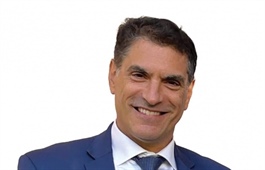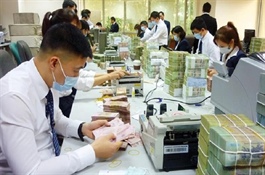Vietnam eyes rate cuts amid ample liquidity and FX pressure
Vietnam eyes rate cuts amid ample liquidity and FX pressure
Hoang Xuan Trung, head of corporation sales and solutions at Citi Vietnam's Global Markets, shared with Nhue Man his insights on how ample liquidity, stable monetary policy, and diversified capital channels are shaping Vietnam’s interest rate strategy and growth outlook.
Interbank overnight rates have fallen below 2 per cent. The market shows little interest in borrowing from the State Bank (SBV) via the Open Market Operation (OMO) due to abundant system liquidity. And some banks are continuing to lower deposit rates. What is your assessment of this development?

Hoang Xuan Trung, head of corporation sales and solutions at Citi Vietnam's Global Markets |
From June 18-24, overnight interbank market interest rates dropped below 2 per cent, reflecting abundant liquidity in the interbank market. Commercial banks have shown little to no interest in borrowing from the State Bank of Vietnam (SBV) through the OMO channel, which offers an interest rate of 4 per cent for a maximum term of three months.
Abundant liquidity in the interbank market (secondary market) provides favourable conditions for commercial banks to consider adjusting their interest rate policies in the primary market (including deposit and lending rates for both organisations and individuals), maintaining or reducing them to reasonable levels. This trend is reasonable for several reasons.
First, the SBV has issued clear directives and guidelines, targeting credit growth for the banking system at 16 per cent in 2025. To achieve this target, interest rates must be kept at reasonable levels.
Second, although the Federal Reserve has not cut interest rates this year, many economists forecast that it is only a matter of time before rate cuts begin. This anticipation serves as one of the foundations for the SBV to consider maintaining or further lowering market interest rates.
Third, the government and the SBV are continuing to manage monetary policy in a stable manner, ensuring high economic growth and effective exchange rate control. Confidence in stable growth and consistent monetary policy supports the rationale for lowering deposit interest rates.
Interbank exchange rates have reached record highs. In your view, how will this affect interest rate policy?
According to public data, as of June 23, the VND had depreciated by approximately 2.6 per cent against the US dollar (USD) compared to the end of 2024. Exchange rate movements undoubtedly influence interest rate management.
Current interest rates are at reasonable levels, and businesses are absorbing capital well, with GDP growth remaining positive. However, interbank interest rates must not fall too low, especially not diverging too far from USD-based rates like the secured overnight financing rate, to avoid encouraging speculation on USD purchases, which could adversely affect the USD/VND exchange rate.
The SBV must strike a balance, maintaining reasonable interest rates while closely monitoring global interest rate trends, especially moves by the Fed. According to Citi economists, the VND is not expected to depreciate as much in 2025 (~5.0% in 2024), and downward pressure on the VND is expected to ease as the Fed begins to cut rates. These are important preconditions for the SBV to continue considering interest rate cuts without adding pressure to the VND exchange rate.
Fitch Ratings recently reaffirmed Vietnam's credit rating at BB+ with a stable outlook. Fitch forecasts Vietnam’s GDP growth at only 5.6 per cent in 2025 and 5.3 per cent in 2026, while the Vietnamese government maintains a high growth target for 2025. What role does monetary policy play in stabilising financial markets while supporting economic growth?
Following the US announcement of a 46 per cent tariff on Vietnamese goods, economists noted that such a measure could impact the FDI environment and potentially affect Vietnam’s economic growth in 2025. At that time, our forecast for Vietnam’s economic growth was in the range of 5-6 per cent for 2025.
However, as countries now have 90 days to negotiate tariffs with the US, the trend of early and increased exports to the US has positively impacted Vietnam's export growth.
Moreover, registered FDI in Vietnam grew by over 60 per cent in the first half of the year. These realities have led us to revise our forecast. In early June, Citi adjusted Vietnam’s GDP growth forecast for 2025 to 6.3 per cent, reflecting a more optimistic view on Vietnam’s economic performance this year.
Monetary policy, particularly the maintenance of a low-interest-rate environment, plays a crucial role in sustaining this positive growth momentum.
To achieve higher growth, the government has taken comprehensive measures such as accelerating public investment, creating supportive policy frameworks for private sector development, and committing to the establishment of an International Financial Centre (IFC).
Given today’s highly complex geopolitical landscape, we highly value the SBV’s flexible approach to monetary policy, grounded in persistent goals of high economic growth, stable exchange rates, and controlled inflation.
The SBV governor noted that credit has reached 134 per cent of GDP. Domestic investment heavily relies on bank credit, including medium- and long-term loans, creating risks for the economy. In your view, what is the solution to this issue?
The banking system is currently bearing the bulk of the economy’s medium- and long-term lending needs, functions that ideally should be served by the capital market. At present, corporate bonds are primarily issued by real estate developers, banks, and a few consumer goods firms, which means the capital market has not fully played its role in mobilising medium- and long-term capital for the economy.
Sooner or later, we must expect more diversified channels for raising medium- and long-term capital, rather than relying primarily on bank credit, especially as the government sets high growth targets and aims to unleash vast resources for private sector development.
These capital-raising channels will include traditional tools such as the corporate bond market and IPOs by major enterprises, as well as breakthrough solutions like establishing an IFC, and developing mechanisms for innovative financing instruments, such as securitising future cash flows and receivables.
- 13:17 02/07/2025


























